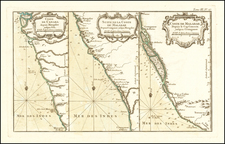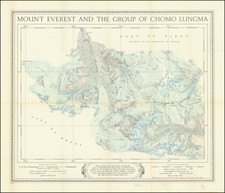Fine old color example of Gerard De Jode's map of Eastern Asia, published in 1593, Engraved by Joannes and Lucas van Deutecum, who's signature is in the lower left part.
De Jode's map is drawn directly from the first (northern) two sheets of Giacomo Gastaldi's rare 4-sheet wall map of Southeast Asia, China and India, perhaps the single most influential map of the region published in the 16th Century. The map extends from China and the Philippines to India and Mongolia.
Gastaldi's map of Southeast Asia has a remarkable history. The map begins with the publication of a single section in 1559, which was intended as a separate map. Additional sections were added in 1561, creating the portion of the existing map which extends south to the Equator. In 1565, two additional sections were added, in order to show all of Indonesia and neighboring islands as far south as Java Minor.
As noted by Suarez:
In its original form the map extended only to the equator, so that most of the Indonesian islands were not included. To remedy this, in about 1565, two narrow sheets were made by the great Italian engraver Paolo Forlani to supplement the main body of Gastaldi's map... This lower addition bears an inscription in the lower left corner which reads 'si vende...'... indicating the location of the shop of the publisher Bertelli.
Suarez notes that Gastaldi's map "had a major influence on the work of Ortelius and de Jode... In their representation of the coastlines his maps are superior to all previous known maps of Asia, either drawn by hand or printed" (Schilder in The Map Collector no. 17, p. 7).
In his excellent study of Gastaldi's maps of Asia and their relationship to the accounts of Marco Polo's travels, Nordinskold notes that while Gastaldi has clearly incorporated information from Marco Polo's travels, Gastaldi has relied upon the accounts of other contemporary travellers to the east. Most notably, the dedication to Marco Fuchero (Marcus Fugger, 1529-1597), is strong evidence that Gastaldi had been given access to the Fugger family library, one of the most important libraries compiled in the 15th and 16th Centuries. During the 16th Century, the Fugger Library was perhaps the best private library in the world, even better than the Vatican Library.
Nordinskold goes on to note:
Finally, it must be remembered that Gastaldi, under the guidance of Ramusio, is supposed to have aided in repairing or repainting the famous wall-maps in Sala dello scudo in Venice . . . If such was the case, it may be considered probable that the monumental maps of Africa and Asia by Gastaldi have had some connection to [Gastaldi's map of Asia], that these copper-plate engravings are a reproduction of the originals of the wall maps in that form which was given them in the middle of the sixteenth century.
First issued in De Jode's Speculum Orbis Terrarum in 1578, the map is among the most influential maps of Eastern Asia published in the 16th Century.
Gerard De Jode (1509-1591) was a pre-eminent mapmaker in the late seventeenth century, a time when the Dutch dominated the map trade. He was known for his many maps, some of which featured in Speculum Orbis Terrae (first edition Antwerp: 1578). Although never as successful as Ortelius’ Theatrum, the Speculum did get republished in a second edition in 1593, two years after De Jode’s death, by Arnold Coninx, and included this map. After his death, Gerard’s son, Cornelis (1568-1600), and his wife, Paschina, ran the shop. Unfortunately, Cornelis died young in 1600, aged only 32, and the stock and plates were sold to the publisher Joan Baptista Vrients.










![[Straits of Malacca, Sumatra, Java and Western Borneo]](https://storage.googleapis.com/raremaps/img/small/51765.jpg)
![[Whampoa]](https://storage.googleapis.com/raremaps/img/small/90211.jpg)
![[Trekking in the Himalayas]](https://storage.googleapis.com/raremaps/img/small/43997.jpg)
![Tabula Asiae IX [Northern India & Pakistan]](https://storage.googleapis.com/raremaps/img/small/77557.jpg)
